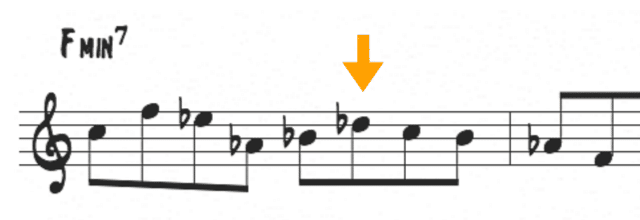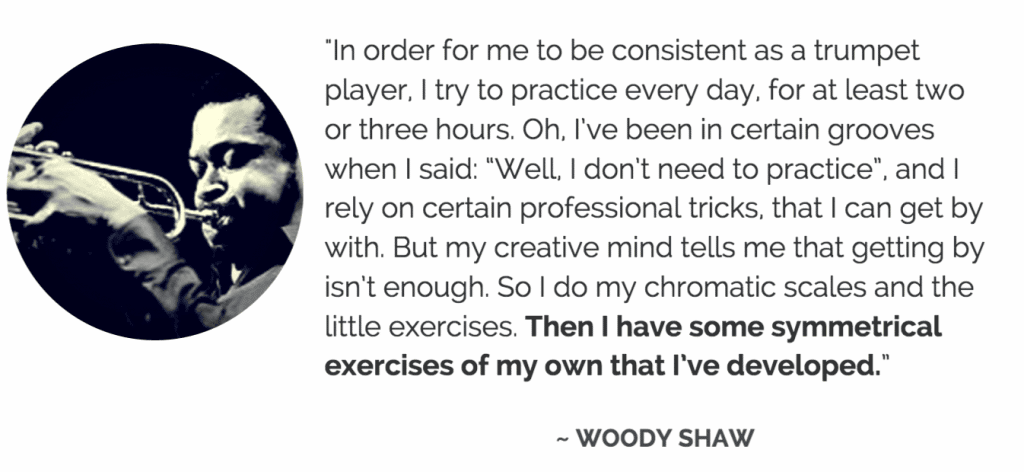Every musician wants to sound hip and modern…To play complex lines that move outside of the harmony and above the time. Solos that’ll make your fellow musicians shake their heads in disbelief and leave the audience speechless. The only problem is that few players actually get to this point, and even less sound authentic, unique, or even innovative in their efforts.
However there is one musician in the jazz lineage who achieved this and more – Woody Shaw.
And today we’re going to dive into one of his live performances to uncover some of the key devices he used to create a highly innovative approach to improvisation.
To start out, have a listen to Woody Shaw’s solo on the tune Stepping Stone:
The solos and ensemble playing sound complex, however the chord progression for the solo sections is deceptively simple:
And by studying how Woody Shaw plays over just two simple chords you can get a glimpse into his larger approach to improvisation.
The way he plays over an extended dominant chord or minor 7 chord is directly connected to the complex lines and harmonies that he uses in every other solo.
Let’s take a closer listen…
Breaking down the solo
At a quarter note equals 400+ bpm it’s hard to hear the individual ideas that Woody is playing.
So let’s slow down the tempo and take a close listen to each line so you can actually hear what’s going on…
Below I’ve transcribed Woody’s two chrouses from the video above:

As you follow along with the music, listen to how he navigates the two different chords F7 and F-7. Here are the first 32 bars (in concert key):
Make sure you listen a few times to get these lines in your ears. There’s enough info contained in these 32 bars to keep you busy in the practice room for months to come.
Here is the second part of his solo…
10 Modern Improvisation Techniques
Now that you’re familiar with both choruses of the solo, let’s take a closer look at what he’s playing over each chord…
As with any transcription that you do, getting the notes is only the first step. The crucial part comes in figuring out why these notes work and discovering the musical concepts behind them.
This is the only way to eventually utilize these techniques in your own playing – and this is exactly what we’re going to do with Woody’s solo.
There’s a wealth of improvisation concepts packed into these 64 bars, so we’ll break down these techniques into 5 different sections – specifically how Woody…
- Improvises over V7 chords
- Improvises over minor 7 chords
- Applies a unique melodic approach
- Utilizes outside harmonies
- And implements a 3 note chromatic technique to shift key centers
Each technique is something that you can take into the practice room, develop, and with time, apply to your own solos.
Ready to get started? Here are 10 modern improvisation techniques from Woody Shaw’s solo on Stepping Stone…
Dominant 7 language: 3 concepts
To begin, let’s look at 3 concepts Woody Shaw uses to navigate the F7 sound in this solo…
One characteristic that you hear time and again in Woody’s solos are note choices from the upper structure of the chord.
Specifically from the 7th of the chord up to the 9th, 11th and 13th, and this solo is no exception.
In his opening line he utilizes the upper structure of the dominant chord in the following line:
Over an F7 chord he emphasizes G, Eb and D – creating a melodic texture that is “above” the expected harmony.
Practice becoming familiar with the upper structures of the V7 chord in your own solos. A good exercise is to visualize and improvise with the 9th, 11th and 13th of dominant chords in every key:
Using upper structure notes in jazz improvisation is nothing new, but the way in which Woody creates melodic lines and structures with these tones is a unique part of his stylistic approach.
As an improviser, it’s easy to get trapped in the mindset of scales and linear motion…
You look at a V7 chord and immediately think about bebop scales or bebop licks to extend the lines in your solos. But what if you took the same notes of that dominant chord and approached them in a different way?
This is a technique that Woody consciously used to create a unique approach to the traditional diatonic sounds of the jazz language. Check out the line below, which pops up with slight variation in the solo 3 more times:
Instead of the standard linear or bebop approach to a dominant chord, Woody Shaw crafted his own approach that didn’t rely on cliches, yet still adhered to the rules of voice leading and harmony.
To see what I mean, here’s a standard bebop line that you might find in dozens of solos compared to the way Woody improvises over the same chord:
Both lines follow the “rules” of melodic construction by resolving to or emphasizing the 3rd of the chord (A) in the second measure. However, notice how Woody’s line features…
- An intervallic approach to the F7 chord – using 3rd’s and 4th’s
- Diatonic enclosures instead of chromatic enclosures
- Varying direction and shape of the line
The third way that Woody approaches the dominant sound in this solo is by using simple harmonic and melodic techniques to create complex sounding lines.
It’s important to remember that great melodic ideas don’t require exotic scales or advanced harmonic techniques – you can create interesting melodies with very simple ideas.
One of the ways he achieves this effect is by creating melodic shapes with two simple musical devices:
- Major triads
- Enclosures
Here are two examples of how Woody uses triadic enclosure in this solo. The first example comes at the end of his first chorus:
Here he encloses the 3rd of a descending second inversion F triad. The second example comes from the opening of his second chorus.
In both cases the result is a modern sounding intervallic line, yet if you look closely he’s using a very simple technique to achieve this effect.
This is a technique that can be used on any chord, so it’s worth spending some time practicing this concept. Here’s a sample exercise that you should do in every key…
And a variation in descending form…
Now let’s switch gears and look at how Woody approaches the minor sounds in this solo…
Minor Chords: 3 concepts
Just like dominant chords, Woody Shaw has a personal language for the way he plays over minor chords.
Here are 3 techniques Woody uses over the F-7 sound in this solo on Stepping Stone…
One of the hallmarks of Woody’s style of improvisation is his use of pentatonic scales and patterns.
As opposed to a traditional diatonic or scalar approach to the minor 7 chord, the pentatonic scale opens up the possibility of different intervallic structures and melodic patterns.
Check out how Woody approaches the notes of the F- pentatonic scale in the line he uses below:
Over an F-7 chord he creates a melody using the F minor pentatonic scale. Notice his creative use of the intervals and linear direction in this line, opting for the larger intervals of 4ths and 5ths inherent within the scale.
Here’s another example of Woody using the same pentatonic scale over a minor chord, however this time he includes some chromatic tones to emphasize goal notes:
The chromaticism of the b13 and major 3rd over the minor 7 chord act as passing tones that emphasize the strong chord tones. Which leads us right into the next two Woody Shaw devices over minor chords…
One way that Woody approaches the minor chord in a creative way is by incorporating the major 3rd into his lines.
He does this in one of two ways: (1) as a passing tone and (2) as an emphasized dissonance.
In the following two examples check out how Woody utilizes the major 3rd (A natural) over the underlying F-7 chord:
In this excerpt, he uses the A natural as a passing tone to the Ab, giving the minor 3rd emphasis and feeling of resolution.
However, in the second example he emphasizes the major 3rd, landing on the A natural on a strong beat in the first measure and sustaining it on the downbeat of the next measure.
Aim to incorporate the major 3rd over minor 7 in both ways – as a passing tone and as an emphasized note that creates harmonic tension.
In many jazz education settings the default way to approach a minor 7 chord is entrusted to one scale…the dorian mode.
As a result it’s easy to get in the habit of approaching every minor chord with this singular scale, however this tactic ignores the full harmonic possibility of the minor sound.
In this solo Woody often expands his harmonic palette to include the b13 over the minor 7 chord. In essence, using the natural minor scale and creating another half-step resolution that emphasizes the strong chord tones.
Just like the b6 in a major bebop scale, the added chromatic note of the b13 adds to the melodic motion and voice leading of your lines.
In this solo, Woody also incorporates the b13 into his pentatonic lines, adding emphasis and chromatic resolution to an otherwise standard pentatonic melody:
Aim to incorporate the b13 or natural minor scale into your arsenal for minor chords, approaching it in a linear way as well as in intervals.
Melodic techniques
Looking at this solo or any other Woody Shaw solo, it’s easy to try to find licks that you can cut and paste into your own solos, but there is something deeper in his approach…
Remember, the secret to mastering the jazz language is not in stealing licks, but in understanding the musical concepts behind these lines so you can use them in any key, any variation, and meld them into your personal sound.
In searching for his sound, Woody Shaw developed certain techniques that allowed him to evolve from the confines of the standard diatonic jazz language and the conventional approach to the trumpet.
Specifically, he broke new ground on the trumpet by:
- Utilizing melodic shapes
- Creating 4 note groupings and combining these units
- Combining standard jazz language with his personal approach
For example take a look at this line that he plays over an F7 chord:
On the surface it might sound like a classic Woody Shaw line, but take another look. Contained in this one line over a static V7 chord, Woody utilizes three separate musical concepts.
In the first measure he applies standard bebop language using enclosures and the bebop scale and in the next measure he utilizes the notes of the Bb major/G minor pentatonic scale, highlighting the upper structure of the sound.
Finally in the 3rd measure he emphasizes the 4th intervals and triads inherent to the F7 sound.
Rather than relying on one approach or scale for this dominant chord, Woody is able to draw from and combine different harmonic and melodic devices that he’s worked out.
Each concept in itself is relatively simple, yet when mastered in every direction and variation they become very powerful.
Chromaticism and outside material
Another hallmark of Woody’s harmonic approach is his ability to easily access outside harmonies and unrelated keys over any progression.
In the second chorus of his solo, Woody begins to explore more outside material on the dominant section of the tune. Here are two examples found in the 8 bars below:
In the first four bars of this passage he begins in F and quickly moves to the altered notes of the F7 sound.
In the second measure he highlights the b13, b9, and #9 of the F7 chord. Using the altered notes of a V7 chord or employing the altered scale are two useful ways of moving quickly outside of the harmony.
In the second four bars he heads outside of the key altogether, substituting the F7 chord:
Here he deliberately plays a half-step above the key – F#- over a static F7 chord. You can also think of this line as the tritone sub or a ii-V7 in the tritone sub (B7 or F#- B7).
Just like the altered notes of a V7 chord, Woody also developed some techniques for escaping the diatonic trap of the minor chord.
The first way he creates harmonic tension in minor is by momentarily slipping out of the established key center. Check out this technique in action in the line below:
Over the F-7 chord he begins in the “related” Bb- pentatonic and then moves outside to F#- pentatonic and finally returns home to F- pentatonic:
The next time you encounter an extended minor chord try slipping in and out of the home key. Start by playing a half-step away from the key and gradually moving along the spectrum of dissonant key centers.
The next way he moves outside on minor is by employing shapes and sequences that move through different keys – take a listen to the line below to see what I mean:
Here he employs a four-note pentatonic sequence that moves down by half-step (F#- to F-):
The sequence and continuity of the melodic shapes is what holds the line together as he moves in and out of the key center.
A method for transitioning to different keys
Listening to this solo, you’ve probably noticed how Woody effortlessly switches between key centers, moving quickly inside and outside of the harmony.
This isn’t by chance, like the other techniques on this list, it’s something that he consciously developed in the practice room.
When Woody quickly switches key centers in this solo he is employing a 3-note chromatic motif that allows him to move seamlessly into unrelated or new keys.
For example, let’s take another look at the line from above where he quickly moves outside from F#- to F-7 over the F-7 section of the tune:
He starts out the line with a Bb- pentatonic pattern and uses the 3 note chromatic pattern as a quick way to transition to an unrelated key, moving to F#-7 and then again to F-7.
You can see him use this 3-note technique in other sections of this solo where he is moving in and out of key centers. In the example below he moves between Eb-/F alt. to F# minor:
This chromatic movement allows him to slip into any key on the fly while keeping the linear motion of the phrase going. And this technique comes directly from the exercises he created for himself to escape the idiomatic confines of the “jazz trumpet” language up to that point.
Woody spent years crafting a unique approach and developing these techniques to get to the point where he could improvise with them at the highest level.
Remember, understanding how they work is one thing, but practicing them until you can improvise with them is another thing altogether!


















































